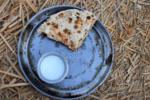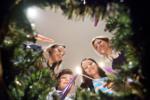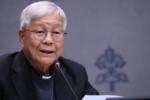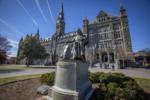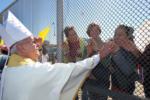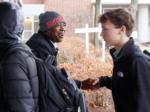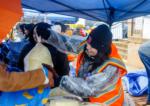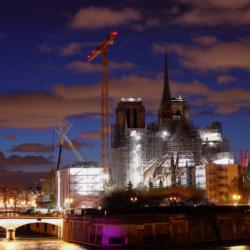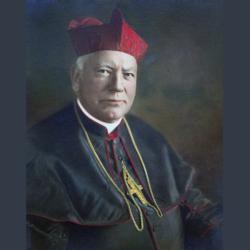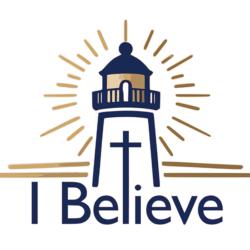See and believe: The shroud bears witness to the lifting up of Jesus
Jesus has been raised up, lifted up for all to see, so that in seeing, we may believe. John puts these images at the center of his Gospel, as we see in chapter eight, when Jesus says, "When you have lifted up the Son of Man, then you will know that I am he" (Jn 8:28). This seems to point clearly to the Cross, when the people of Jerusalem, the you, will lift him to his death to look upon the one they have pierced. But in chapter 12, Jesus refers to being lifted up again: "And I, when I am lifted up from the earth, will draw all men to myself" (Jn 12:32). At first glance, it would seem to be a repetition of the earlier statement, but it follows Jesus's prayer, "Father, glorify thy name" (Jn 12:27). In raising Jesus from the dead, the Father lifted him up from death and exalted him by seating him at his right hand.
These two liftings are intrinsically related. The Jewish authorities working with the Romans raised Jesus on the Cross, seeking to humiliate him. The one who claimed he could destroy the Temple and rebuild it in three days himself has been destroyed. The Father then lifts him up in vindication, building the new, definitive temple in his resurrected body, completing the work of drawing all to him so that they may have life. John seems to draw directly upon Isaiah 52: "Behold, my servant shall prosper, he shall be exalted and lifted up, and shall be very high. As many were astonished at him -- his appearance was so marred, beyond human semblance, and his form beyond that of the sons of men -- so shall he startle many nations; kings shall shut their mouths because of him; for that which has not been told them they shall see, and that which they have not heard they shall understand" (Is 52:13-15). In the exaltation of this man who had been disfigured, they will see and understand that which had been hidden from them.
John specifically uses the words "see" and "believe" at key moments in his Gospel, fulfilling the prophecy of Isaiah about looking upon the Suffering Servant. Standing at the foot of the Cross, the beloved disciple relates, "But one of the soldiers pierced his side with a spear, and at once there came out blood and water. He who saw it has borne witness -- his testimony is true, and he knows that he tells the truth -- that you also may believe" (Jn 19:34-35). And then when he reaches the empty tomb, after waiting for Peter to enter first, he "also went in, and he saw and believed; for as yet they did not know the scripture, that he must rise from the dead" (Jn 20:8-9). The connection between these passages should be clear. In both, John conveyed the testimony of what he saw regarding the two liftings; he believed and passed on his testimony that we might also believe.
But what did he see in the empty tomb that made him believe? That the tomb was empty would not be proof of the resurrection, as Mary Magdalene thought someone had taken his body away. She said this directly to Peter and John: "'They have taken the Lord out of the tomb, and we do not know where they have laid him.' Peter then came out with the other disciple, and they went toward the tomb. They both ran, but the other disciple outran Peter and reached the tomb first; and stooping to look in, he saw the linen cloths lying there, but he did not go in. Then Simon Peter came, following him, and went into the tomb; he saw the linen cloths lying, and the napkin, which had been on his head, not lying with the linen cloths but rolled up in a place by itself." (Jn 20:2-7). What they saw, they led John to believe, was a great sign offering testimony to Jesus being lifted up: The linen cloths.
Gilbert Lavoie convincingly demonstrates how the Shroud of Turin offers testimony to two distinct liftings up of Jesus in his book "The Shroud of Jesus: And the Sign John Ingeniously Concealed" (Sophia Institute, 2023). As a medical doctor, he was intrigued by Dr. Pierre Barbet's "A Doctor at Calvary," which revealed the accurate anatomical details of the Shroud, leading him to speak with members of the STURP research group that had direct access to the Shroud in 1978 and collaborate with some of them. He then began his own simple studies to uncover the way the blood flowed onto the Shroud from Jesus's body.
Tracing a blood stain off to the side of the image, without an existing explanation, he placed a cloth reproduction over his own body to discover that the side of the cloth dripped down around the elbow. He followed the same process for tracing the origin of blood stains across the forehead of the figure. He traced the blood stains and cut off holes in their spot, and then wrapped the tracing around a model's head. He realized that the blood stain that looked like it was in the figure's hair actually wrapped around the side of the head, indicating the cloth was wrapped around the face. This may seem like a minor detail, but it led Lavoie to an important conclusion: The blood stains do not match the image, but they were impressed earlier and in a different shape.
Looking at images of a model he used for this study, he realized that images standing upright matched the face of the Shroud much more closely than those lying flat. Then, something hiding in plain sight became apparent: the figure's hair falls downward, not back. Though he is not standing, as his feet and arms remain crossed, the entire body points to being upright, not supine. "I must admit that I was overwhelmed with the discovery of the upright man. It caused me to back out of the room in awe and respect for what the image of the man of the shroud was visually telling me. My first thought was that indeed this image is a reflection of the moment of his resurrection" (96).
In addition to the stains of blood from the first lifting up in the Passion, the Shroud captures the moment of the resurrection, as the body of Jesus was lifted off the ground. The Shroud bears witness to this moment so that we, like John, may also see and believe.

